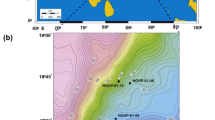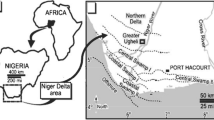Abstract
Measurement of velocity anisotropy is an essential parameter for capturing the heterogeneity of sub-surface geology to characterise the hydrocarbon-bearing reservoir. The incorporation of velocity anisotropy parameters during the preparation of the 3D velocity model represents a robust result in a challenging geological set-up during interpretation. Generally, we can observe that the shale formation is more sensitive to velocity anisotropy response in comparison with other formations such as sandstone, siltstone for clastic reservoir or limestone and dolomite for carbonate reservoir. This study was performed mostly in the high amount shale section mixed with limestone and claystone of the Jaisalmer sub-basin area which lies in the western part of India. The preparation of the velocity model for frequent changes of lithology in the clastic and carbonate reservoir is challenging due to several changes of velocity which show a limitation in the result of the gridded velocity model. The objective of this study is to capture the changes of compressional and shear wave velocity in mixed lithology of the significant shale formation. The idea was due to the inclusion of the anisotropy incorporated changed velocity during the preparation of the gridded velocity model for correctly identified lithology. The shale formation which is the zone of investigation of the current study is situated over a carbonate sequence, and an estimated velocity anisotropy factor of this shale formation will contribute significantly during the cumulative study of velocity modelling of all formation. The current study shows that shale formation shows the character of orthorhombic anisotropy; however, this study was performed based on significant changes of well log data and related effects of vertically transverse isotropic parameters of the shale formation. The fundamental Thomsen anisotropy parameters were estimated by capturing the deviation of five independent stiffness coefficients. Significant changes in evaluated shale velocity were observed after the incorporation of the estimated Thomsen parameter in velocity values.
















Similar content being viewed by others
Abbreviations
- \( \sigma_{ij} \) :
-
Stress tensor
- \( m_{ijkl} \) :
-
A stiffness tensor of rank four
- \( \epsilon_{kl} \) :
-
Tensor of strain
- \( \alpha \) :
-
Biot’s constant
- \( P_{\rm {p}} \) :
-
Pressure of pore spaces
- \( \epsilon \) :
-
Thomsen anisotropy parameter epsilon
- γ :
-
Thomsen anisotropy parameter gamma
- δ :
-
Thomsen anisotropy parameter delta
- V P (90°):
-
P-wave in the vertical direction
- V P (0°):
-
P-wave in the horizontal direction
- V SH (90°):
-
S-wave in the vertical direction
- V SH (0°):
-
S-wave in the horizontal direction
- V ij :
-
Wave travelling in the axis of Xi and polarised along the axis of Xj
- \( \rho\) :
-
Bulk density
- V 12 :
-
Shear wave velocity over the axis (X1) and differentiated on the axis of X2
- V 33 :
-
P-wave velocity travelling in the X3-axis and polarised in the same axis
- V 11 :
-
S-wave velocity propagating along the axis X1 and polarised in the same axis
- V 13 :
-
X-component of S-wave velocity estimated from P-wave velocity
- m 33 :
-
The stiffness constant in the vertical direction
- m 66 :
-
The stiffness constant in a plane which is horizontal that consists of shear wave in the X1 and X2 directions
- m 11 :
-
The stiffness constant in a plane where S-wave is travelling along axis X1 and polarised in the same axis
- m 55 :
-
Stiffness constant in the vertical plane consisting of P-wave along X3 direction and S-wave along X1 direction
- m 13 :
-
The stiffness constant calculated from ANNIE model
References
Alkhalifah T and Tsvankin I 1995 Velocity analysis for transversely isotropic media; Geophysics 60 1550–1566.
Avseth P 2015 Explorational rock physics: The link between geological processes and geophysical observables; Petrol. Geosci., https://doi.org/10.1007/978-3-642-02332-3_18.
Castagna J P, Batzle M L and Eastwood R L 1985 Relationships between compressional-wave and shear-wave velocities in clastic silicate rocks; Geophysics 50(4) 571–581.
Chesnokov E M, Tiwary D K, Bayuk I O, Sparkman M A and Brown R L 2009 Mathematical modelling of anisotropy of illite-rich shale; Geophys. J. Int. 178 1625–1648.
Datta Gupta S and Gupta R 2017 Importance of coloured inversion technique for thin hydrocarbon sand reservoir detection – A case in mid Cambay basin; J. Geol. Soc. India, Springer 90(4) 485–494.
Datta Gupta S, Chatterjee R and Farooqui M Y 2012 Rock physics template (RPT) analysis of well logs and seismic data for lithology and fluid classification in Cambay basin; Int. J. Earth Sci. 101(5) 1407–1426.
Dobson P J 1985 Physical properties of crystals – Their representation by tensors and matrices; Phys. Bull. 36(12) 506.
Far M E, Quirein A J and Mekic N 2015 Orthorhombic model for geomechanical applications in unconventional shale reservoirs; SEG Technical Program Expanded Abstracts.
Han D H, Nur A and Morgan D 1986 Effects of porosity and clay content on wave velocities in sandstone; Geophysics 51 2093–2107.
Higgins S, Goodwin S, Donald Q, Donald A, Bratton T and Tracy G 2008 Anisotropic stress models improve completion design in the Baxter shale, Society of Petroleum Engineers (SPE)/115736; Annual Technical Conference and Exhibition, Denver, Colorado, USA.
Hornby B E 1994 The elastic properties of shales; PhD Thesis, University of Cambridge, Cambridge, Massachusetts, 201p.
Lee M W 2010 Predicting S-wave velocities for unconsolidated sediments at low effective pressure; U.S. Geological Survey Scientific Investigations Report, 2010–5138, 13p.
Loucks R G, Reed R M, Ruppel S C and Jarvie D M 2009 Morphology, genesis, and distribution of nanometer-scale pores in siliceous mudstones of the Mississippian Barnett Shale; J. Sedim. Res. 79 848–861.
Mavko G, Mukerji T and Dvorkin J 2009 The rock physics handbook; Cambridge University Press, Cambridge.
Norris A and Sinha B 1993 Weak elastic anisotropy and the tube wave; Geophysics 58 1091–1098.
Nye J F 1985 Physical properties of crystals: Their representations by tensors and matrices; Oxford University Press, Clarendon Press, New York, 329p.
Okorie I P C, Ebeniro J O and Ehirim C N 2016 Anisotropy and empirical relations for the estimation of anisotropy parameters in Niger Delta depobelts; Int. J. Geosci. 7 345–352.
Ostadhassan M, Zeng Z and Jabbari H 2012 Anisotropy analysis in shale using advanced sonic data – Bakken case study; AAPG Bull., Annual Convention and Exhibition, Search and Discovery Article.
Prasad M 2002 Acoustic measurements in unconsolidated sands at low effective pressure and overpressure detection; Geophysics 67 405–412.
Prasad M and Nur A 2003 Velocity and attenuation anisotropy in reservoir rocks, Society of Exploration Geophysicists (SEG) Technical program, Dallas, Texas.
Ross D J K and Bustin R M 2008 Characterizing the shale gas resource potential of Devonian–Mississippian strata in the Western Canada sedimentary basin: Application of an integrated formation evaluation; AAPG Bull. 92 87–125.
Ross D J K and Bustin R M 2009 The importance of shale composition and pore structure upon gas storage potential of shale gas reservoirs; Mar. Pet. Geol. 26 916–927.
Ruger A 1998 Variation of P-wave reflectivity with offset and azimuth in anisotropic media; Geophysics 63 935–947.
Ruger A 2002 Reflection coefficients and azimuthal AVO analysis in anisotropic media; Society of exploration geophysicists (SEG), Tulsa.
Sayers C M 1994 The elastic anisotropy of shales; J. Geophys. Res.-Sol. EA 99 767–774.
Sayers C M 2005 Seismic anisotropy of shales; Geophysics 64 93–98.
Sharma K K 2007 K–T magmatism and basin tectonism in western Rajasthan, India, results from extensional tectonics and not from reunion plume activity; Geol. Soc. Am., https://doi.org/10.1130/2007.2430(35).
Shipley T H, Ogawa Y, Blum P, Bahr J M, Bruckmann W, Moran K and Housen B A 1997 Directional properties of P-wave velocities and acoustic anisotropy in different structural domain of the Northern Barbadose ridge Accretionary complex; In: Proceedings of the ocean drilling program, scientific results, 156p.
Shoenberg M, Muir F and Sayers C M 1996 Introducing ANNIE: A simple three parameters anisotropic velocity model for shales; J. Seism. Explor. 5 35–49.
Simm R and Bacon M 2014 Seismic amplitude: An interpreter’s handbook; Cambridge University Press, Cambridge, 84p.
Tatham R H and McCormack M D 1991 Multicomponent seismology in petroleum exploration; Society of Exploration Geophysicists (SEG), Tulsa.
Thomsen L 1986 Weak elastic anisotropy; Geophysics 51(10) 1954–1966.
Tsvankin I 1997 Seismic signatures and analysis of reflection data in anisotropic media (1st edn); Elsevier Science, Amsterdam, 29p.
Tsvankin I 2005 Seismic signatures and analysis of reflection data in anisotropic media (2nd edn); Elsevier Science, Amsterdam.
Vernik L L and Liu X 1997 Velocity anisotropy in shales – A petrophysical study; Geophysics 62 521–532.
Walsh J, Sinha B and Donald A 2006 Formation anisotropy parameters using borehole sonic data, Society of Petrophysicists and Well Log Analysts (SPWLA) 47th annual logging symposium, Veracruz, Mexico.
Zimmer M A 2003 Seismic velocities in unconsolidated sands – Measurements of pressure, sorting, and compaction effects; PhD Thesis, Palo Alto, Calif., Stanford, 204p.
Acknowledgements
The authors are thankful to NDR (National Data Repository), DGH (Director General of Hydrocarbon), India and GSPC, Gandhinagar, India for providing technical data support for research. The authors are profoundly thankful to Geophysical Data Quantitative Interpretation Lab. (GQIL), Department of Applied Geophysics, IIT(ISM) Dhanbad for providing support to carry out this research work. The authors would like to acknowledge M/s Schlumberger for providing R&D license for the research work. We are obliged to the reviewers of the Journal of Earth System Science for their critical review of this paper.
Author information
Authors and Affiliations
Corresponding author
Additional information
Communicated by N V Chalapathi Rao
Rights and permissions
About this article
Cite this article
Pradhan, N., Datta Gupta, S. & Mohanty, P.R. Velocity anisotropy analysis for shale lithology of the complex geological section in Jaisalmer sub-basin, India. J Earth Syst Sci 128, 209 (2019). https://doi.org/10.1007/s12040-019-1226-2
Received:
Revised:
Accepted:
Published:
DOI: https://doi.org/10.1007/s12040-019-1226-2




